Surface organization of a DPPC monolayer on concentrated SrCl2 and ZnCl2 solutions†
Abstract
Transition metals are known to be enriched in organic-coated marine aerosols, but the impact these cations have on their surface properties is not well understood. Here the effect of Zn2+ enrichment on the surface properties of a dipalmitoylphosphatidylcholine (DPPC) monolayer was investigated and compared to that of the alkaline earth metal Sr2+, an ion not enriched in aerosols. Phase behavior of the DPPC film on concentrated aqueous solutions was probed with surface pressure–area isotherms while domain morphology was monitored with Brewster angle microscopy (BAM). Infrared reflection–absorption spectroscopy (IRRAS) and vibrational sum frequency generation (VSFG) spectroscopy were used to assess the impact of cations on the conformation and orientation of alkyl chains as well as the hydration state of the carbonyl and phosphatidylcholine (PC) moieties. Results of compression isotherms and BAM show that Zn2+ strongly interacts with DPPC molecules, and induces condensation of the monolayer while Sr2+ only weakly interacts with the monolayer in expanded phases. Conformational order and orientation of alkyl chains in the condensed phase are not significantly altered by either cation. IRRAS indicates that Sr2+ has weak interactions with the PC headgroup. Zn2+ ions cause dehydration of carbonyl groups and binds to the phosphate group in a 2 : 1 bridging complex. Findings here suggest that Sr2+ is not enriched in aerosols because it behaves similar to a monovalent ion and only weakly interacts with the monolayer, while enrichment of Zn2+ is due to strong binding to the lipid film.

- This article is part of the themed collection: Soft Matter at Aqueous Interfaces


 Please wait while we load your content...
Please wait while we load your content...